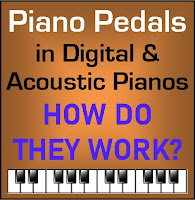 PIANO PEDALS – SPECIAL REPORT – UPDATED REPORT – Jan 1, 2025 – Piano Pedals in Acoustic & Digital Pianos – Damper or Sustain Pedal, Sostenuto Pedal, Soft Pedal. Are they important and how should they work? Piano pedals and how they work and what they do are extremely important to the piano playing experience that you get playing either an acoustic or digital piano. Without good working piano pedals that can help you control the piano sound so that your music sounds good, your music will suffer unless you choose the right piano with the right pedals. This report will tell you what YOU need to know when shopping for a Digital Piano!
PIANO PEDALS – SPECIAL REPORT – UPDATED REPORT – Jan 1, 2025 – Piano Pedals in Acoustic & Digital Pianos – Damper or Sustain Pedal, Sostenuto Pedal, Soft Pedal. Are they important and how should they work? Piano pedals and how they work and what they do are extremely important to the piano playing experience that you get playing either an acoustic or digital piano. Without good working piano pedals that can help you control the piano sound so that your music sounds good, your music will suffer unless you choose the right piano with the right pedals. This report will tell you what YOU need to know when shopping for a Digital Piano!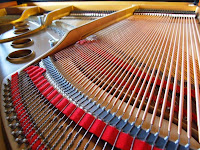 First of all, it is important to know that without a right (damper) pedal on an acoustic or digital piano, the piano would not sound very good and your music would generally not be considered to be beautiful, pleasing, lush, resonant, or full. A real acoustic piano has lots of strings inside (over 200) and when you press a key, the hammer mechanism inside strikes the string and then you hear the piano sound vibrating. It’s like what happens on a guitar too; when you strike or strum a string(s) with your finger, you hear the guitar sound and that sound keeps going (sustaining) until you put your finger or hand on that string and then the sound stops sustaining/vibrating. In other words, you can mute the sound of the guitar string with your fingers whenever you want after you strike/pluck the string or strings.
First of all, it is important to know that without a right (damper) pedal on an acoustic or digital piano, the piano would not sound very good and your music would generally not be considered to be beautiful, pleasing, lush, resonant, or full. A real acoustic piano has lots of strings inside (over 200) and when you press a key, the hammer mechanism inside strikes the string and then you hear the piano sound vibrating. It’s like what happens on a guitar too; when you strike or strum a string(s) with your finger, you hear the guitar sound and that sound keeps going (sustaining) until you put your finger or hand on that string and then the sound stops sustaining/vibrating. In other words, you can mute the sound of the guitar string with your fingers whenever you want after you strike/pluck the string or strings.
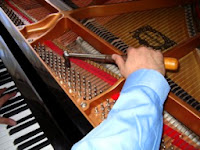 I will refer to the piano sustain time in this discussion as decay time. The right piano pedal is referred to as damper pedal because on the inside of the piano you have lots of strings, as I mentioned earlier, and all of those strings will sustain unless there are dampers on or in-between them. In fact, grand pianos have approximately 230 strings, so imagine tuning all those strings so the piano can sound good….that is a very big and difficult job if you don’t know what you’re doing. So it’s important that your acoustic piano get tuned by a qualified tuner/technician.
I will refer to the piano sustain time in this discussion as decay time. The right piano pedal is referred to as damper pedal because on the inside of the piano you have lots of strings, as I mentioned earlier, and all of those strings will sustain unless there are dampers on or in-between them. In fact, grand pianos have approximately 230 strings, so imagine tuning all those strings so the piano can sound good….that is a very big and difficult job if you don’t know what you’re doing. So it’s important that your acoustic piano get tuned by a qualified tuner/technician.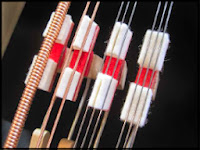 OK, so what is a damper, anyway?! I was mentioning previously that a guitar string will continue to make sound after you strum or pluck it until the sound fades away naturally or you put your fingers or hand on the string. In a piano the damper does the same thing as your fingers or hand. It mutes the piano string(s) and stops it from vibrating and making sound. The dampers are small wedges or blocks of felt glued to a piece of wood and connected to a mechanism (a damper rail) which operates all of the dampers at the same time when pressing the right damper pedal on your piano. Felt dampers can be different sizes and/or shapes depending on which and how many strings they are muting at one time. If you look at the left pictures, you’ll notice different size dampers on different sized strings.
OK, so what is a damper, anyway?! I was mentioning previously that a guitar string will continue to make sound after you strum or pluck it until the sound fades away naturally or you put your fingers or hand on the string. In a piano the damper does the same thing as your fingers or hand. It mutes the piano string(s) and stops it from vibrating and making sound. The dampers are small wedges or blocks of felt glued to a piece of wood and connected to a mechanism (a damper rail) which operates all of the dampers at the same time when pressing the right damper pedal on your piano. Felt dampers can be different sizes and/or shapes depending on which and how many strings they are muting at one time. If you look at the left pictures, you’ll notice different size dampers on different sized strings.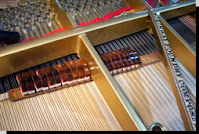 So they are not all the same. Normally when the piano damper pedal is not pressed and is in its normal up position, the damper felts are directly on the strings, muting all of them except for the last (approx) octave and 1/2 of the keys which is about 19 black & white keys on an average acoustic piano, depending on the make and model of piano. The highest strings need to vibrate all the time without being muted by dampers at any time, so they do not have dampers at all. There are good reasons for that being the case, but all we need to know at this point is those last octave & 1/2 of strings don’t have dampers because they need to sustain all the time.
So they are not all the same. Normally when the piano damper pedal is not pressed and is in its normal up position, the damper felts are directly on the strings, muting all of them except for the last (approx) octave and 1/2 of the keys which is about 19 black & white keys on an average acoustic piano, depending on the make and model of piano. The highest strings need to vibrate all the time without being muted by dampers at any time, so they do not have dampers at all. There are good reasons for that being the case, but all we need to know at this point is those last octave & 1/2 of strings don’t have dampers because they need to sustain all the time.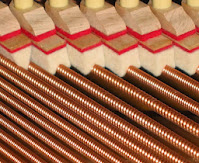 As an example, if you pushed the damper pedal down and didn’t let it come back up and then played a very low bass key, you would hear that bass string inside the piano continue to make sound until you released the pedal back up. The bass strings are large and thick (left pic) and therefore will normally have a much longer time of natural sustain than higher strings when the pedal is pressed down. As I mentioned earlier but it’s worth repeating, natural decay time on a real acoustic piano which is the time it takes for the sound to fade away after striking a key while holding the pedal down, can be as short as a few seconds on the high strings to about 50 seconds or more on the low bass strings depending on the the size (depth) of a grand piano or the height of an upright acoustic piano.
As an example, if you pushed the damper pedal down and didn’t let it come back up and then played a very low bass key, you would hear that bass string inside the piano continue to make sound until you released the pedal back up. The bass strings are large and thick (left pic) and therefore will normally have a much longer time of natural sustain than higher strings when the pedal is pressed down. As I mentioned earlier but it’s worth repeating, natural decay time on a real acoustic piano which is the time it takes for the sound to fade away after striking a key while holding the pedal down, can be as short as a few seconds on the high strings to about 50 seconds or more on the low bass strings depending on the the size (depth) of a grand piano or the height of an upright acoustic piano.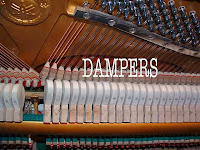 With the dampers up off the strings when you press the damper pedal down, you get a resonant, big, full, piano sustaining sound, especially when playing many keys at the same time. The piano sound can become very beautiful that way and makes you sound even better than you are because that extra resonating sustain time covers up mistakes you would hear more clearly if you did not push the damper pedal down. However, without pressing the damper pedal down, then all the notes play in a staccato (quick) fashion where the sound is immediately heard and then stops as soon as you let go of the key. I have heard children/students in my music studio play piano holding the damper pedal down with their little foot and when they just play on most any key, it just sounds better that way.
With the dampers up off the strings when you press the damper pedal down, you get a resonant, big, full, piano sustaining sound, especially when playing many keys at the same time. The piano sound can become very beautiful that way and makes you sound even better than you are because that extra resonating sustain time covers up mistakes you would hear more clearly if you did not push the damper pedal down. However, without pressing the damper pedal down, then all the notes play in a staccato (quick) fashion where the sound is immediately heard and then stops as soon as you let go of the key. I have heard children/students in my music studio play piano holding the damper pedal down with their little foot and when they just play on most any key, it just sounds better that way.It’s funny to watch the younger kids 4-6 years old lean off the edge of their piano bench so they can get their foot on the pedals since their legs are not long enough otherwise:). In the beginning, especially for smaller children, playing the damper pedal is not important because the student is learning about fundamentals of piano music such as rhythm & timing, note reading, fingering movement and position, and other aspects of playing.
But once they become more proficient, then using the damper pedal becomes important so they can actually play the music the way it was intended to be heard. It really doesn’t take long for this to happen and kids love to push on the pedal because they think it’s fun and makes their music sound cool:)
 An important aspect in damper pedal use and the effect it has on the piano sound is how far down you push the pedal, which determines how far off the strings the dampers are. This kind of behavior is known as half-damper or variable sustain. If the piano pedal is up in its normal resting position, the felt dampers are on the strings stop the sustain piano sound. If the pedal is pressed all the way down, the felt dampers are completely off the strings so the sustain effect is completely on maximum. However, in a real acoustic piano, the felt dampers can also be partially on the strings but not completely on or off. This happens when the pedal is pressed approximately half way down.
An important aspect in damper pedal use and the effect it has on the piano sound is how far down you push the pedal, which determines how far off the strings the dampers are. This kind of behavior is known as half-damper or variable sustain. If the piano pedal is up in its normal resting position, the felt dampers are on the strings stop the sustain piano sound. If the pedal is pressed all the way down, the felt dampers are completely off the strings so the sustain effect is completely on maximum. However, in a real acoustic piano, the felt dampers can also be partially on the strings but not completely on or off. This happens when the pedal is pressed approximately half way down.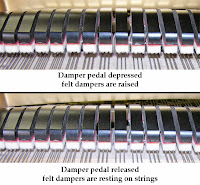 A real acoustic piano has this middle area of sustain which is not quite off and not quite on. It’s a transitional point when playing music and using the damper pedal. It occurs naturally on all acoustic pianos and is something which is necessary to have. If you are a beginner, then that natural half-pedal effect will be of little or no importance to you and you will probably not notice it. But as you progress and become more proficient in your playing, you’ll want to know your piano can do this half-pedaling and that it becomes a part of playing the piano.
A real acoustic piano has this middle area of sustain which is not quite off and not quite on. It’s a transitional point when playing music and using the damper pedal. It occurs naturally on all acoustic pianos and is something which is necessary to have. If you are a beginner, then that natural half-pedal effect will be of little or no importance to you and you will probably not notice it. But as you progress and become more proficient in your playing, you’ll want to know your piano can do this half-pedaling and that it becomes a part of playing the piano.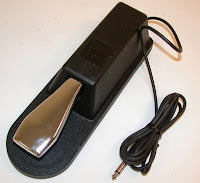 On most digital keyboards which have less than 88 keys and the keys are not weighted, including some keyboards that have good piano sounds, there is usually no half-damper pedal effect when pressing the basic pedal down. Most keyboards only come with one damper/sustain pedal (left pic) which is OK, but if that pedal cannot digitally reproduce the authentic characteristics of real acoustic damper pedal playing, then I call that a concern if your goal is to play piano music correctly and you are at or want to be at a higher playing skill level. If the instrument pedal cannot produce the half-damper effect, then you need to consider that before making a purchase. Most piano pedals on digital keyboards and furniture cabinet pianos look very similar so you cannot just tell by the looks of the pedal if it actually will operate like a real acoustic piano pedal. You need to look at the actual piano specifications to know for sure.
On most digital keyboards which have less than 88 keys and the keys are not weighted, including some keyboards that have good piano sounds, there is usually no half-damper pedal effect when pressing the basic pedal down. Most keyboards only come with one damper/sustain pedal (left pic) which is OK, but if that pedal cannot digitally reproduce the authentic characteristics of real acoustic damper pedal playing, then I call that a concern if your goal is to play piano music correctly and you are at or want to be at a higher playing skill level. If the instrument pedal cannot produce the half-damper effect, then you need to consider that before making a purchase. Most piano pedals on digital keyboards and furniture cabinet pianos look very similar so you cannot just tell by the looks of the pedal if it actually will operate like a real acoustic piano pedal. You need to look at the actual piano specifications to know for sure.Without this naturally occurring element in acoustic pianos, those pianos with likely sound almost fake and unrealistic, like you had cut something out of the sound. Whether or not a person can actually hear all of these naturally occurring organic elements that occur when using the damper pedal is directly related to their piano playing experience and their piano skill level, and even the type and age of the piano they are playing.
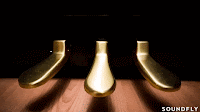 It is important to note that I did not discuss the middle and left pedal in this report because they are seldom used as compared with the damper sustain pedal, but do have there place in music and piano playing and should not be overlooked. The middle pedal is called the sostenuto which sustains the only the notes that you play when holding down the pedal and any subsequent notes after that while still holding down the pedal are staccato notes. So the middle sostenuto pedal is a simultaneous mix of sustain notes and quick staccato notes.
It is important to note that I did not discuss the middle and left pedal in this report because they are seldom used as compared with the damper sustain pedal, but do have there place in music and piano playing and should not be overlooked. The middle pedal is called the sostenuto which sustains the only the notes that you play when holding down the pedal and any subsequent notes after that while still holding down the pedal are staccato notes. So the middle sostenuto pedal is a simultaneous mix of sustain notes and quick staccato notes.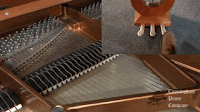 However, for the vast majority of piano students and recreational piano players, it’s the “damper-sustain’ pedal which is most important and a part of the piano buying decision that needs to be considered when doing your research and trying out pianos. There are a few other aspects and details of piano damper pedaling in acoustic & digital pianos that I did not talk about here such as the speed at which the dampers come back down on the strings in an acoustic piano when the damper pedal is released, called Key-Off effect. This effect is reproduced in certain digital pianos increasing the authenticity of the true piano sound and pedaling experience. However, I wanted to keep this content as simple as I could and not get too caught up in minute details which most people shopping for digital pianos may likely not recognize when they hear them.
However, for the vast majority of piano students and recreational piano players, it’s the “damper-sustain’ pedal which is most important and a part of the piano buying decision that needs to be considered when doing your research and trying out pianos. There are a few other aspects and details of piano damper pedaling in acoustic & digital pianos that I did not talk about here such as the speed at which the dampers come back down on the strings in an acoustic piano when the damper pedal is released, called Key-Off effect. This effect is reproduced in certain digital pianos increasing the authenticity of the true piano sound and pedaling experience. However, I wanted to keep this content as simple as I could and not get too caught up in minute details which most people shopping for digital pianos may likely not recognize when they hear them.If you want more info on new digital pianos and LOWER PRICES than internet discounts, please email me at tim@azpianowholesale.com or call direct at 602-571-1864.





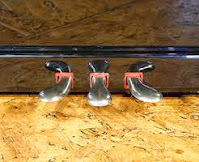





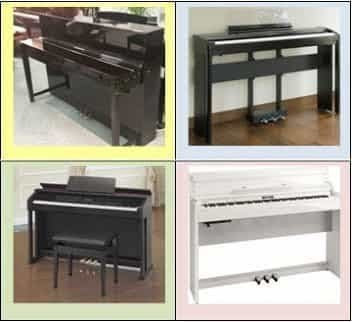




I really like the sound of an upright piano with the soft pedal engaged. I have come across some virtual instruments (e.g. Felt Piano) and even an iPad instrument (Soft Piano in iGrand), but haven't yet found a digital piano with a good soft pedal sound. Are you able to make a recommendation? Ideally I'm looking for a furniture model in the 1000 – 2000 USD range.
I have played many digital pianos that have had an acceptable soft pedal including Roland, Kawai, etc in different price ranges. On some of those pianos you can also change the piano voicing to a mellow and softer tone to emulate a soft pedal. So there are different ways on different models to get what you want. Curious as to what pianos you played that did not have a soft pedal that was acceptable to you?